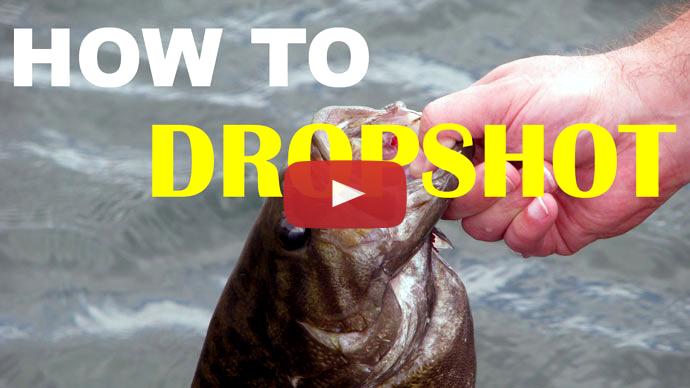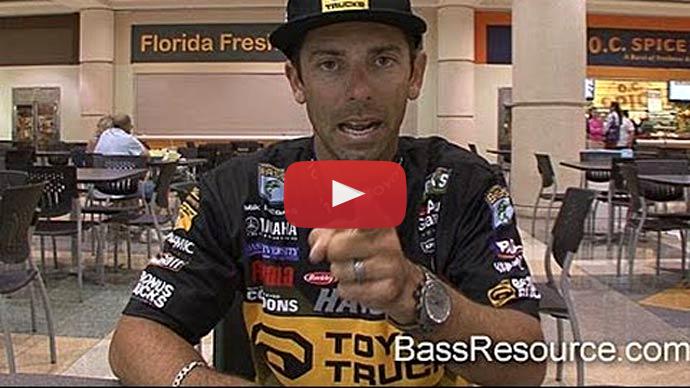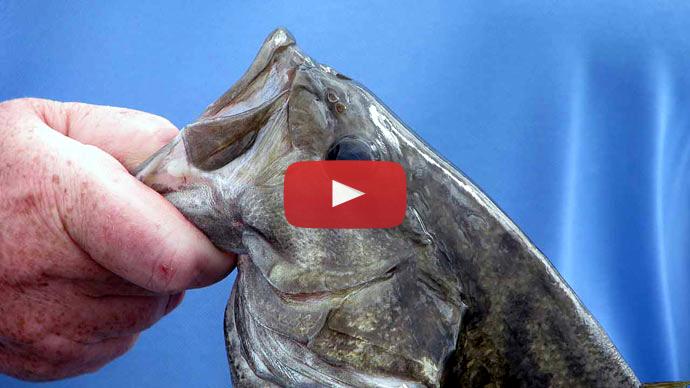Keri: Come here you. Where are you? I know you're here somewhere. Come here. He wants to fight. Here you go.
Glenn: Another dropshot bass.
Keri: Good ol’ dropshot bass. Come here. I got you right in the corner of the mouth. You are not going anywhere. Fun little guys. Cute little guy. He's cold. There you go, little guy. Thought he was gonna come right back in the boat.
Glenn: Hey, folks. Glenn May here with BassResource.com and today, let's talk about dropshot fishing in the fall. How to catch fish with a dropshot. Now, this is a great technique to use during the time of the fall when the fish just aren't as actively feeding. This is when the dropshot comes in. When those fish don't want to chase down crankbaits like they normally do in the fall or hit those top waters, but they're sitting out there lethargic and they're sitting on certain types of structure, you can pick them apart and take that school apart and catch a lot of fish using the dropshot. So, that's what I wanna talk about today.
So, first, I wanna talk about the rod and reel and the rig that I'm using. I'm using a seven-foot medium light power rod with a fast action tip. So, lots of spring to it. Lots of give because this is a light line technique I'm using. It all revolves around the hook. I'm using a real light wire size one hook. So, you need equipment that's got a lot of give to it because you can either bend that hook or you can rip it out of the fish's mouth while you're fighting it back to the boat. If you're using really strong line or stout rod, you can lose a lot of fish that way. So, you need equipment that's matched to that hook in order to get that fish in the boat. So, I'm using this real light limber rod. Paired with it, I'm using 6.2-pound fluorocarbon line. This is Seaguar finesse line. Love this stuff. Seaguar, they invented fluorocarbon. I don't know if you knew that or not, but they invented fluorocarbon fishing line.
So, because of that, they actually make their own fluorocarbon resin that is made specifically for fluorocarbon fishing lines. The only manufacturer that actually makes that. They do it themselves and the whole production process all the way through. They are in control of it. High-quality standards, that's why they can make 6.2-pound line when nobody else can because they can make it to exacting standards. And I found that I can go down to 6.2 without any more break-offs or having to retie as much because this fluoro finesse line that Seaguar makes is, to me, just as good, as far as strength and durability, abrasion resistance and durability as 10-pound line plus I get that sensitivity and the bait is a lot more natural moving in the water because I'm using that lighter line.
And as the fall progresses, the water starts to clear up more and more and more. And the more it clears up, the more visible braid becomes. You don't wanna be using braid with this for that reason plus braid has no stretch at all. And when you're using this light wire hook, that's exactly the opposite of what you want because the braid can basically bend out this hook or rip it around the fish's mouth.
Don't even try using leaders this way because... fine. Put in 5, 10-foot leader, whatever you want but that's not gonna make up for the detrimental effects of braid in this case. Braid just isn't a good choice. Braid also is buoyant, braid is gonna get this bow in the water when you're using dropshot technique. So, you don't have as good connectivity with it.
I know finesse line is very expensive or fluorocarbon line is really expensive so I put some backing on the reel and only spool up about 60 to 80 yards of it at a time so I can stretch that spool out and use it a lot longer. It's a great cost-effective way of using it.
But at any rate, that's the line I'm using. And now here, what I'm using is a VMC's Spinshot hook. You see that? I can spin it and it doesn't twist the line. That's one of the reasons why I really like it. I've got it nose-hooked here. I'm just using the finesse worm in this case. Sometimes I'll use a small minnow type bait to imitate the baitfish that the bass are feeding on. But that Spinshot not only reduces lying twist but it also makes the bait... the bait can act more natural in the water.
Keri: I got a fish. Believe it or not. I threw it way out there in the middle of nowhere and caught a fish.
Glenn: It was sitting on these little drops.
Keri: Nice.
Glenn: Well, that's a good fish.
Keri: Come here, little guy. In the middle of nowhere. I threw to a dark spot and that wast it. Threw it to a dark spot. Another little pound and a halfer.
Glenn: And I've just got a regular old dropshot on the end of it. This is an eight-ounce dropshot weight. This works really well for me. The teardrop, it's got a little swivel on it so it doesn't get hung up on stuff. I also have some that are more of a cylinder shape which works really well in rocky areas so it doesn't get hung up as much. Although I don't fish a dropshot in, say, rip rap. I've just come to the conclusion I get way too frustrated. When I try to fish in the rip rap, you're just asking for trouble. Regardless of what kind of weight that you have, it's going to get hung up in rip rap. So, I don't use in rip rap.
But what I do use it for is in the fall. Again, the bite is off a little bit. This is a great time to bring it out. When the fish, you can nurse an area and you can catch a lot of fish.
So, typically what that is, is there's two different ways I really do this is I split the fall into two different seasons. One is that early fall which is late summer until the water temperatures get into the 50s, mid 50s or so. And then from that point to early winter, where the water temperatures get into the low and mid 40s, that's the second part of the fall. And I fish in those two seasons, if you will, or two parts of the fall differently.
So, in the first half, what I'm doing is I'm looking at the main lake points that are entrances to bays and coves that have freshwater flowing into them. The baitfish at this time of year are looking for freshwater, they're moving up shallow so the bass are gonna follow them.
Now, if I come to a bay that doesn't have any freshwater then I'll just skip it. I'll go to the next one because the more freshwater that is in there, the more oxygen-rich water that's in the water or in the bays that is going to attract those fish. So, I wanna fish high percentage areas so that's where I'll go.
So, I'll start on the outside of those areas and I'll take this dropshot and I'll pinpoint the key structure areas. Would be in a drop-off, in a hump, a ridge, rock pile or a point, you wanna throw it out there and basically all you do is you just let it sit out there, let it fall. And in this time of year you'll sometimes get bit as the bait falls. The fish may just come up, they're sitting on that piece of structure and they'll see it coming down to them and they'll swim up and grab it. So, watch your line carefully as it's falling. Look for it to pop, twitch, jump, do anything unusual and that could be a fish.
But let's just say it does get to the bottom and typically it does, all you're gonna do is reel up and then you're just gonna make a good connection with the line. Make a nice straight connection with a line. Hard to do with braid because you get that bow in a line. You're only gonna end up moving the bait, you wanna do that. You just wanna hold that one position and then all you're gonna do is to shake it just a little bit. Give it a little shake and stop, give it a little shake and stop. You just wanna shake the rod tip. That's all you're looking to do is to shake that rod tip just like that. Okay. See how much this bait's moving, when I do that? when you get a tight line, it's just dancing around in that water. Doesn't take much. So, just shake it just a little bit and pause and wait. Hang out for a little bit and then give it another little shake. And a lot of times the line will just start swimming off. You don't really feel the fish. It's a light bite. If you don't get bit, lift up, reposition it, and then do it again. Just let it sit there and give it a little shake, sit, give it a little shake.
Keri: Come here, you little feisty thing. Come hither. You already feisty thing. Here you are. You already feisty one. Not happy at all about having something that in his mouth. Another little dropshot bass. Come hither. Another little guy. He was almost behind the boat.
Glenn: Yup, there’s something about that spot back there.
Keri: They're cold.
Glenn: Because again, this is a great time to fish those areas where you know the fish are hanging off of these pieces of structure or relating to it but they're just not biting faster moving baits. That's when you wanna do it. You're not gonna cover a lot of water with a dropshot. Keep that in mind. It's not a good search bait or a good search technique, but it's good for picking apart those areas when the fish just aren't really wanting to bite but, you know, they're sitting on that cover.
Now, if you don't catch any fish there, then start moving yourself up shallow. Again, this is in that early, the first half of fall. Move up shallower and start targeting any kind of cover that you see. Be it a stump field, chunk rock, laydowns, that type of thing. Outside weed lines, docks are really good for fish in this too. So, it's a great way to cover a little shallow water or shallow areas and you can nurse an area and catch a lot of fish.
Once you catch a fish, make sure that you keep working that because you're probably into a school. They roam in packs this time of year. Anywhere from 3 to 25 fish in a pack. So, if you catch one, just keep throwing that area general vicinity and work it pretty good. Crisscross, come in different directions and so you'll likely catch several more fish in that area.
Now, if I did do all that and I still haven't caught any fish, then I'll pull out to the main creek channel and those coves and bays and I'll start fishing there. A lot of times the fish will relate to that area. They may be a little suspended off of it, but I'll focus on those creek bends where they come closer to the shoreline or where they intersect with a point or, say, a sandbar or something like that, shallower water. And specifically, I like to fish the inside bends of those channels where it's shallower and the currents a little bit slower. You wanna look for any kind of cover along there like stump fields or chunk rock or maybe a weed bed. Then I'll really target it and I'll just work it real nice and slow with this dropshot. That's a great place to go and pick off a lot of fish when you can't find them up on the shoreline.
Now, going into that second part of the season that I mentioned about when the water temp's in that mid to lower 50s and start getting colder and getting closer to winter, the fish are gonna pull out of those shallow areas and start moving deeper where they're gonna set up shop for winter. So, I start hitting the main lake areas, I start hitting those main points, those humps, those ledges, those drop-offs. That's what I really wanna target with this bait.
What I like to do, if you're in the northern part of the North America, what happens is the perch will start to school up. They'll bunch up and they'll relate to offshore structure but they won't be on it. They'll ball up but they'll out away from the shoreline. But some of them are dying off and they'll sink down to the bottom. And the bottom part of that ball of fish and that's where the bass are. They sit up underneath them and they feed on the perch.
So, what I like to do with the dropshot is I'll put a heavier weight on here. I'll put a half-ounce on here and what I'll do is I'll try to drop this bait through that school of perch. Now, if you guys caught a lot of fish or you fish lakes that have a lot of perch on it, you know what I'm talking about. You fish in a plastic, those perch are gonna attack it, they'll annihilate it. So, I want it to go fast, that's why I'm using a half-ounce weight. I wanna punch through that school without the perch getting to it. And when it comes through to the bottom, that's where the bass are waiting with open mouths.
It's a cool little technique to use during the fall. You locate those pods of perch on your depth finder and then punch through them with your dropshot, with your... I use a minnow-sized bait, whatever they're feeding on at the time. Something that's similar and looks like what they're feeding, like a perch. Punch it through them. When you get through the bottom of that perch ball, boom. You'll catch usually a nice sized fish. Usually, the good-sized bass are sitting underneath those pods. So, that's a great way to catch some large fish during late fall.
Keri: Oh, you're pulling like you're mean.
Glenn: There you go. That's a good fish. There. There you go. That's a largemouth.
Keri: Oh, boy. You are not happy with me.
Glenn: There we go. That does the trick.
Keri: That does the trick. Dropshot fish, there we go. There we go. Much better fish. Much better.
Glenn: That works.
Keri: That's what we've been waiting all day for.
Glenn: That's a good one.
Keri: Thank you, dude. Good little belly on him..
Glenn: Yeah. That works.
Keri: My little fish. Dropshotting. Here you go, baby. Thank you for the play. That was fun.
Glenn: In the summertime, this is what I'm using. A little bit longer leader into the early fall, a longer leader so I can get more of those fish because they're more actively roaming, but in the wintertime when you're getting closer to winter and into the fall, I might have a shorter leader like that because the fish are closer to the bottom, they're hugging the bottom, they're not really gonna relate any higher than that, they're not gonna chase fish as much. So, I'll shorten that up and then what I'll do is I'll just drag it then. I'm not really lifting it up and dropping it now, I'm just dragging it using the rod tip and I'll just drag it off that piece of structure, just slowly working it down along the edge.
As a matter of fact, if it's a steeper drop, I might even do the opposite. Park my boat in shallow water, throw it out in the deeper water, and slowly work it up. That way I don't lose contact with the bottom, I don't have to keep feeding that line as it gets deeper and I can just reel up on it then just use my reel slowly working on up and pause it and shake the rod tip a little bit, move it up, pause it and shake the rod tip a little bit.
Look at this. You go fish and drop off or ledge, you position your boat up shallow to fish uphill, and the fish that are on the ledge just said, "Hey, your boat is a good piece of structure... or sorry, a good piece of cover and provides some shade." So, they move up from 16 feet to 4 right under the boat. It's like crappy fishing off a dock. Yeah. Right under the boat.
Keri: Yeah. That's a bigger one.
Glenn: Right directly under the boat. Nah. We're not gonna go on the ledge, we wanna go under the boat. Sometimes these bass just don't read the same books we do.
Anyway, that's the way I fish a dropshot for the fall. I hope that helps. For more tips and tricks like this is, visit the BassResource.com.



